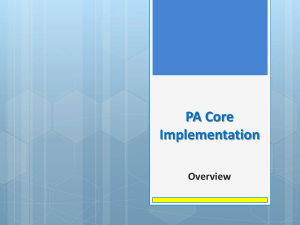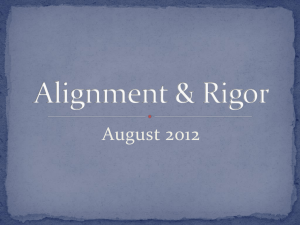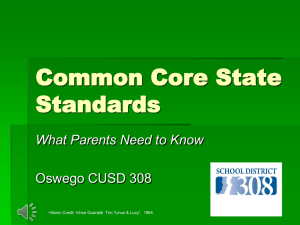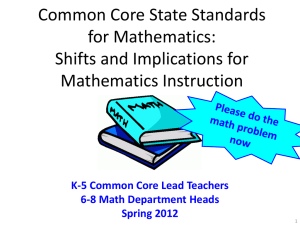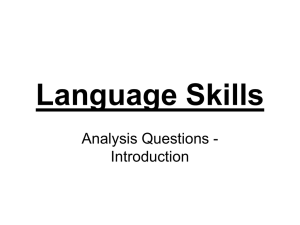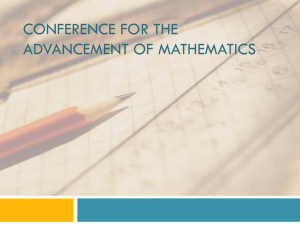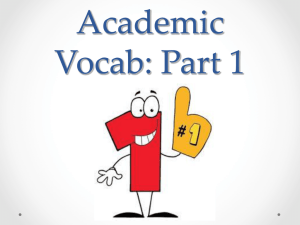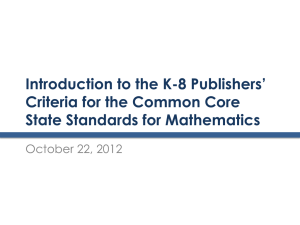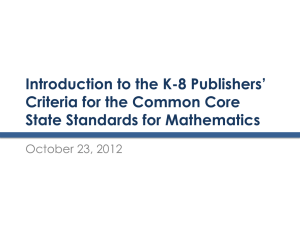Differentiating Instruction in Mathematics
advertisement
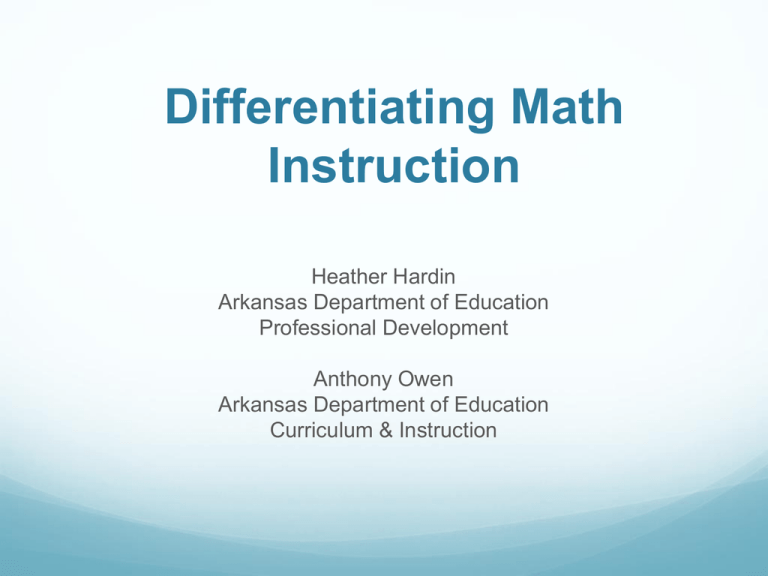
Differentiating Math Instruction Heather Hardin Arkansas Department of Education Professional Development Anthony Owen Arkansas Department of Education Curriculum & Instruction Key Shifts in Mathematics Focus - the major focus in each grade allows the emphasis on the concept to deepen Coherence - there are coherent progressions from grade to grade Rigor - with equal concentration, the three aspects of rigor must be practiced: 1. Conceptual Understanding 2. Procedural Skills and Fluency 3. Application FOCUS Greater focus on fewer topics: Grades K–2: Concepts, skills, and problem solving related to addition and subtraction Grades 3–5: Concepts, skills, and problem solving related to multiplication and division of whole numbers and fractions Grade 6: Ratios and proportional relationships, and early algebraic expressions and equations Grade 7: Ratios and proportional relationships, and arithmetic of rational numbers Grade 8: Linear algebra and linear functions COHERENCE Progression charts show coherence across grades: Where to find them: ime.math.arizona.edu/progressions/ Members on the working team: Richard Askey (reviewer), Sybilla Beckmann (writer), Douglas Clements (writer), Phil Daro (co-chair), Skip Fennell (reviewer), Brad Findell (writer), Karen Fuson (writer), Roger Howe (writer), Cathy Kessel (editor), William McCallum (chair), Bernie Madison (writer), Dick Scheaffer (writer), Denise Spangler (reviewer), Hung-Hsi Wu (writer), Jason Zimba (co-chair) More progression examples… https://education.ohio.gov/getattachment/Topics/Academic-Content-Standards/Mathematics/Resources-Ohio-s-New-Learning-Standards-K-12-Mathe/K-8-Standards-Progressions-2-1412.pdf.aspx RIGOR Rigor is achieving at high levels, not making things harder 3 aspects of rigor: 1. Conceptual Understanding- comprehension of mathematical understandings that use prior knowledge and new learnings 2. Procedural Skills and Fluency – skillfully and efficiently performing accurate procedures 3. Application- applying and modeling skills and concepts to unfamiliar circumstances How can you differentiate math instruction across grades and maintain FOCUS, COHERENCE, and RIGOR? The answer… THREE-ACT TASKS Let’s try one… ACT 1: How big is the killer’s shoe size? What do you notice? What questions do you have? What does a wrong answer look like? What’s your guess? What is an answer that would be way too high? Too low? ACT 2: What more information do you need to answer our question? How would you get it? Let’s compare the original guesses… Largest 1st guess:_____ Smallest 1st guess:_____ Difference:_____ Largest answer:_____ Smallest answer:_____ Difference:_____ ACT 3: Why was your answer close but not exact? What did your model/ work not include that it should have? What did your model work include that it should not have? If we were going to title the lesson for today, what would a good title be? Consider these things: What math did we use? What math did we use that we already knew? What new math did we use? SEQUEL (optional) How big would Bigfoot’s foot look next to the dollar bill? How big would Mini me’s foot look next to the dollar bill? (Mini me from Austin Powers) Bone Collector Three-Act Task Standards addressed: 6.RP.3: Use ratio and rate reasoning to solve real-world and mathematical problems, e.g., by reasoning about tables of equivalent ratios, tape diagrams, double number line diagrams, or equations. Ratio and Proportions across grades: 6th grade: Understand ratio concepts and use ratio reasoning to solve problems. 7th grade: Analyze proportional relationships and use them solve real-world and mathematical problems. 8th grade: Understand the relationships between proportional relationships, lines, and linear equations. to Three Act Task Act 1: Show students a video or picture that will “hook” them Pose the question for the lesson. Avoid using content “language” or vocabulary Possible questions to get students thinking: What do you notice in the video/ photograph? What’s your guess? What is a guess that is way to high? Too low? What questions do you have? Three-Act Task cont’d Act 2: Ask: What information do you need to answer the question? Students begin gathering information and/ or tools to answer the question Remember: Do not give students information, resources, or tools until they realize they need it and ask for it The teacher serves as a resources and supports the students thinking as they work Three-Act Task cont’d Act 3: Students are provided the answer Discuss answers that were too high/ too low Ask students what information they needed but did not have and what information they had but did not need Have students create a title for the lesson that relates to the math used Make sure the students know what was intended to be learned Three-Act Task cont’d Sequel: Pose a question for the students that extends the learning Other Three Act Tasks threeacts.mrmeyer.com robertkaplinsky.com/lessons/ http://mr-stadel.blogspot.com/p/3-actcatalog_17.html http://wyrmath.wordpress.com (Would you Rather?) Arkansas Department of Education Heather Hardin Office of Professional Development Director: Kevin Beaumont 501-682-4232 Anthony Owen Office of Curriculum & Instruction Director: Stacy Smith 501-682-7442

